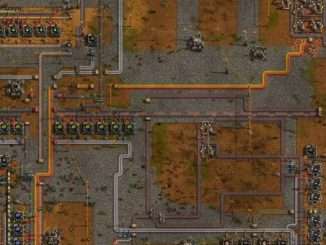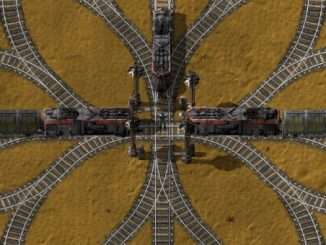
Burrowing, flying, and naval biters, and the player’s own counters to them.
Guide to Military Overhaul
Land
Burrowers
Worms that ignore your surface defenses by tunneling below them. When they emerge, they destroy whatever you built in that location and spray globs and acid at your buildings from deep inside your base. When a behemoth burrower emerges, the part the player can see is the size of a rocket silo and it will attack everything within a half-chunk radius.
Burrowers are best countered before they strike, via seismic detection and artificial earthquakes. Yes, you’ll destroy every structure in the chunk anyway, but at least (if targeted well) it’ll be an empty chunk instead of a core part of your base.
Air
Airbases
Required for all player units except helicopters. These can be crude airstrips (least capacity), sprawling organized airports (high capacity), or compact spires (high capacity for smaller units only). All airbase units require fuel and will automatically retreat to the closest airbase when their fuel runs too low. If they don’t make it back, they’ll crash. Helicopters will instead safely touch down until they can be refueled by hand or automated logistics vehicles. All aerial biters can safely touch down like helicopters, but instead “refuel” on their own while grounded by absorbing nearby pollution.
Hangars
All air units are built here, then transported to your airbases for deployment.
Flight missions can be pre-programmed patrol or strike routes, or specific orders to attack a certain target or concentration. In the latter case, when that concentration is destroyed, the unit will return to base and forget the order.
Air superiority
Movement ignores all barriers, whether natural or artificial. Units are even against each other, strong against anti-ground flyers, and ineffective against surface targets. Counter with destroyers and AA turrets and vehicles.
Anti-ground flyers (bombers and helicopters)
Movement ignores all barriers, whether natural or artificial. Units are strong against surface structures and vehicles but ineffective against other flyers. Counter with air superiority units (preferred) or surface anti-air.
Air transports
Movement ignores all barriers, whether natural or artificial. Units have no combat ability but the land units they deposit behind your defenses can make a mess of your base if they aren’t caught in time. Cargo transports are part of your logistics system, using airbases as their version of rail stations. Troop transports can move land units. Tankers allow mid-air refueling and can stay airborne indefinitely, provided you keep them supplied. Unlike trains, cargo transports will pathfind their own routes from one airbase to the next.
AWACS
Player-only aerial radars with patrol routes and extreme range. No combat ability of their own.
Anti-air counters
Biters have their own air superiority, anti-ground, and transport units. Gun turrets and SAMs are the primary static choices to take them out, while anti-air modules are available for cars and other vehicles. Spidertrons and destroyers have native anti-air options. Biters have their own static and mobile anti-air options as well.
Sea
Shallows vs. (continental) shelf
Currently-existing water is redefined as shallows. If a newly-generated water chunk is far enough away from a shore, the water tile there will instead be a shelf and the chance of more land in that direction will drastically fall. Chunks with shelf tiles have a chance of containing extremely large and rich oil deposits, upon which you can build platforms for drilling. Oil platforms collect crude much faster than pumpjacks, but can’t be walled in for protection. Defend your oil platforms from the biters with AA turrets, submarine turrets, and air and sea patrols. Landfill cannot be used on shelf tiles, only shallows, but you can “pave” the surface between oil platforms to connect them into larger floating islands. Offshore platforms on the shelf can be powered using seafloor cables.
Shelf vs. deep ocean
If you explore a shelf even farther away from the shallows, you’ll eventually hit the deep ocean. Biters are deathworld-common here, in large surface nests, and any cargo ships that you’ve assigned to cross deep ocean will likely require escorts. Players can’t build structures on deep-ocean tiles.
Seamounts
Mechanically, these are just isolated patches of “shelf” surrounded by deep ocean. They contain ore deposits that (like offshore oil) are much richer and are mined much faster than land deposits. They might even work infinitely like oil. Seamount facilities are defended the same way as offshore oil. As with shelves, players can create artificial floating islands out of the platforms above their seamount facilities. Seamounts rely on marine current, geothermal, or wirelessly-transmitted power, as the deep ocean is too deep for cables. Underwater production is another option for especially large seamounts: process the ore on-site and compress them into more efficient stacks, just like on land.
Ports and Shipyards
Must be placed on a flat coastline. All naval units are built at shipyards, while ports do double duty as home (refueling) bases for your naval units and land-sea connections for your greater logistic network.
Canals
Build to connect lakes to Nauvis’s larger oceans, so a shipyard built on one of the former doesn’t become obsolete as you expand.
Naval biter nests
Two kinds, surface and submarine. Surface nests can be destroyed with battleships, bombers, or artillery, just like land nests; subs will also work. Submarine nests will not spawn in the shallows or deep ocean and are best countered with destroyers and subs, just like submarine units. When clearing naval surface nests on the shelf, always bring some sonar along so you don’t miss any submarine nests that were hiding under them.
Destroyers
Light surface units. Strong against air (missiles) and subs (sonar and depth charges), and economical against carriers (once all their flyers are shot down) and naval transports. Ineffective against battleships, which you should counter them with.
Battleships
Heavy surface units. Their cannons are strong against all other surface units and both land and sea structures (bombardment). Cannot attack or even detect submarine units and structures. Counter with bombers or subs.
Carriers
Naval airbases. No inherent combat ability, but air units can operate and refuel from them just as effectively as regular airstrips. Cannot detect submarine units, nor can these carry the heaviest bombers.
Submarines
Can submerge in non-shallow water to become completely invisible to enemies (outside of sonar range). Counter with destroyers, which can see them. Subs have their own sonar, so yours will work in a pinch if you’re willing to trade losses.
Naval transports
As with air transports, you have 3 kinds: cargo ships, tankers, something for land units. Biters, lacking an economy, only have the last. Naval transports can only travel on water, but carry as much cargo as large trains, far more than air transports. Cargo ships and tankers have routes between ports just like trains and train stops, but the ships will pathfind their own shortest routes from each stop to the next. As with airbases, cargo and fluids at a naval port can be moved out via belt, pipe, bot, train, or even the little logistics trucks from AAI and other mods.
Naval combat is mostly symmetrical. Biters have their own counterparts to your destroyers, battleships, carriers, submarines, unit transports, and surface and submarine turrets.





Be the first to comment